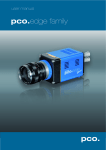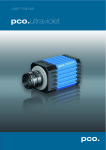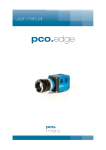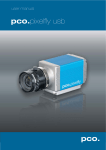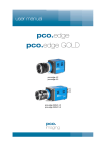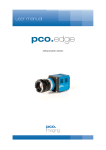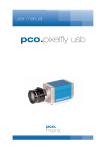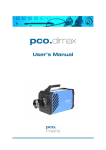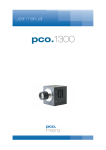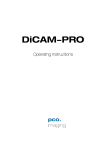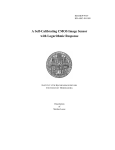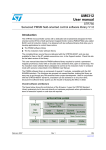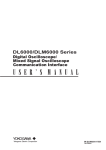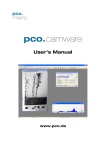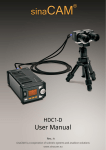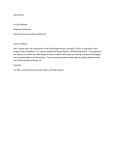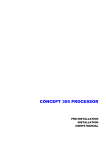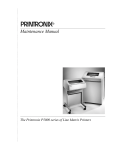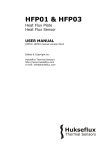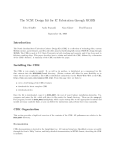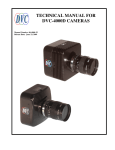Download pco.edge family pco.
Transcript
user manual pco.edge family pco. Target Audience: This camera is designed for use by technicians, engineers, and scientists. In case of any questions or comments, please contact us at PCO. telephone +49 (0) 9441 2005 50 fax +49 (0) 9441 2005 20 email [email protected] postal address PCO AG Donaupark 11 93309 Kelheim, Germany The cover photo shows an exemplary PCO camera system. The lens is sold separately. Copyright © 2014 PCO AG (called PCO in the following text), Kelheim, Germany. All rights reserved. PCO assumes no responsibility for errors or omissions in these materials. These materials are provided as is without warranty of any kind, either expressed or implied, including but not limited to, the implied warranties of merchantability, fitness for a particular purpose, or non-infringement. PCO further does not warrant the accuracy or completeness of the information, text, graphics, links or other items contained within these materials. PCO shall not be liable for any special, indirect, incidental, or consequential damages, including without limitation, lost revenues or lost profits, which may result from the use of these materials. The information is subject to change without notice and does not represent a commitment on the part of PCO in the future. PCO hereby authorizes you to copy documents for non – commercial use within your organization only. In consideration of this authorization, you agree that any copy of these documents, which you make, shall retain all copyright and other proprietary notices contained herein. Each individual document published by PCO may contain other proprietary notices and copyright information relating to that individual document. Nothing contained herein shall be construed as conferring by implication or otherwise any license or right under any patent or trademark of PCO or any third party. Except as expressly provided, above nothing contained herein shall be construed as conferring any license or right under any PCO copyright. Note that any product, process, or technology in this document may be the subject of other intellectual property rights reserved by PCO, and may not be licensed hereunder. Released May 2015 © PCO AG pco.edge family User Manual V2.10 © PCO AG, Germany TABLE OF CONTENTS TOP 1. INTRODUCTION 5 1.1 DATA OVERVIEW 6 2. SAFETY INSTRUCTIONS 7 3. SYSTEM COMPONENTS 8 4. INSTALLATION 9 4.1 CAMERA DRIVER 9 4.2 CAMWARE 10 5. QUICK START 11 5.1 PREPARATION 11 5.2 START 11 5.3 YOUR FIRST IMAGE 12 6. CAMERA CONTROL 13 6.1 THE CAMERA CONTROL WINDOW 13 6.2 THE TIMING TAB 14 6.2.1. ROLLING SHUTTER 17 6.2.2. GLOBAL SHUTTER 21 6.2.3. GLOBAL RESET 24 6.3 THE SENSOR (SIZE) TAB 26 6.4 THE SENSOR (MISC.) TAB 27 6.5 THE RECORDING TAB 28 6.6 THE I/O SIGNALS TAB 31 7. CAMWARE FEATURES 33 7.1 IF NO CAMERA IS DETECTED (DEMO MODE) 33 7.2 OVERVIEW 34 7.3 THE FILE MENU 35 7.4 THE CAMERA MENU 39 7.5 THE ACQUISITION MENU 40 7.6 THE VIEW MENU 41 7.7 THE WINDOW MENU 44 7.8 THE HELP MENU 44 7.9 THE LOCAL MENU 45 7.10 ADDITIONAL FEATURES 46 3 APPENDIX 47 A1 MECHANICAL DIMENSIONS 48 A2 CHANGE FROM F-MOUNT TO C-MOUNT 50 A3 WATER COOLING OPTION PCO.AQUAMATIC II 51 A3.1 SYSTEM COMPONENTS 51 A3.2 FIRST TIME INSTALLATION 52 A3.3 OPERATION 53 A3.4 DIMENSIONS 54 A4 CAMERA LINK 55 A4.1 INSTALLATION OF FRAME GRABBER 55 A4.2 IMAGE DATA FLOW 57 A5 USB 3.0 59 A5.1 HARDWARE RECOMMENDATIONS 59 A5.2 USB 3.0 FAQ 61 A5.3 INSTALLATION OF THE USB 3.0 CARD 63 A5.4 RING BUFFER AND FIFO 64 A5.5 USB 2.0/3.0 FOL EXTENDER 65 A6 BINNING IN CMOS SENSORS 66 A7 LIGHTSHEET SCANNING MODE 67 A8 IMAGE FILE FORMATS 68 A9 CUSTOMER SERVICE 70 A9.1 SERVICE AND MAINTENANCE 70 A9.2 TROUBLE SHOOTING 71 ABOUT PCO 72 4 1 INTRODUCTION 1. INTRODUCTION Advantages of the pco.edge family The pco.edge family is a breakthrough in scientific imaging cameras. It has the distinctive ability to simultaneously deliver extremely low noise, high frame rates, wide dynamic range, high quantum efficiency, high resolution and a large field of view - all in one image. The camera’s main features (model-specific) • • • • ultra low noise 0.8 electrons med (pco.edge (gold) 4.2) high resolution 5.5 megapixel (pco.edge 5.5) best dynamic range 36000:1 (pco.edge (gold) 4.2) high-speed 100 fps @ full resolution (pco.edge 4.2 & 5.5, Camera Link) • high quantum efficiency up to 70% (pco.edge 4.2) • deep cooling down to - 30 °C (pco.edge gold, water cooling) • flexibility user selectable choice of shutter mode • free of drift stabilized Peltier cooling in order to avoid any drift phenomena in image sequences Areas of Application • • • • • • • • • • • • live cell microscopy single molecule detection localization microscopy lightsheet microscopy selective plane illumination microscopy SPIM structured illumination microscopy SIM TIRF microscopy / waveguides spinning disk confocal microscopy genome sequencing (2nd and 3rd gen) FRET 5 • • • • • • • • • • • • • • FRAP lucky astronomy / imaging adaptive optics solar astronomy fluorescence spectroscopy bio- & chemiluminescence high content screening photovoltaic inspection x-ray tomography ophthalmology flow cytometry biochip reading machine vision spectral (hyperspectral) imaging • laser induced breakdownspectroscopy (LIBS) 1.1 DATA OVERVIEW Overview – Available camera models This table shows an overview over all available camera models. Type pco.edge 3.1 Interface USB 3.0 pco.edge 4.2 LT USB 3.0 pco.edge 4.2 USB 3.0 pco.edge 4.2 Camera Link pco.edge 5.5 USB 3.0 Read Out Frequency Rolling 105 MHz 24.93 50 Global 204 MHz 12.80 48 Global Reset 105 MHz 24.99 50 Rolling 110 MHz 24.10 40 Global Reset 110 MHz 24.10 40 Rolling 110 MHz 24.10 40 Global Reset 110 MHz 24.10 40 95.3 MHz (slow scan) 27.60 35 272.3 MHz (fast scan) 9.65 100 Rolling 86 MHz 30.5 30 Global 160 MHz 16.40 28 Global Reset 86 MHz 30.51 30 95.3 MHz (slow scan) 27.52 33 286 MHz (fast scan) 9.17 100 286 MHz 9.17 50 95.3 MHz (slow scan) 27.52 33 286 MHz (fast scan) 9.17 100 Rolling Rolling pco.edge 5.5 Camera Link Line time (µs) Shutter Global Global Reset FPS Sensor mono & color mono mono mono mono & color mono & color pco.edge gold 4.2 USB 3.0 Rolling 110 MHz 24.10 40 mono pco.edge gold 5.5 USB 3.0 Rolling 86 MHz 30.50 30 mono & color 6 2 SAFETY INSTRUCTIONS 2. SAFETY INSTRUCTIONS Please read the safety instructions completely Never operate the camera in humid or dusty environments or in places with high amounts of X-ray radiation. Humidity, dust or Xrays could damage the camera. To avoid the risk of water condensation, protect the camera against extreme changes of ambient temperature. If condensation enters the camera, there is the risk of electric shock. To prevent damage to the camera, the system must be kept stable and protected against strong jolts or vibrations. The socket at the bottom of the camera is to be used for mounting purposes only. Electric shock warning – Never slide any items through slits or holes into the camera because of the risk of electric shock if the voltage parts inside are touched. Each time the camera is used, check the power cable for any damage. Never position the cable in a way that it could become a tripping hazard. Do not force the lens onto the camera. To protect the lens connector thread from damage, use minimal force when attaching a lens to the camera. If any of the following conditions apply, immediately switch off the camera, separate it from the power line and contact our customer support: If the power cable or the power plug seems to be worn or damaged. If liquids have penetrated the device. If, after thoroughly reviewing the instruction manual, the device is still not operating properly. If the camera has been dropped or the casing is damaged. 7 3. SYSTEM COMPONENTS The camera system includes the following parts. Camera Head F-mount optical connection (standard) For standard F-mount / SLR lenses and adapters. C-mount ring provided (see appendix A2) For standard C-mount and microscopy connectors. DC Power Jack (connect to power supply) Input/Output 4x SMA connectors 2x input - 2x output Interface (user selectable) Dual Camera Link full or USB 3.0 LED indicates camera status Green continuous: camera is booting Green blinking: camera is ready for operation Yellow blinking: recording on error Red blinking: Serial Number Tag (on the bottom of the camera) Mounting Thread 1/4-20 UNC mounting thread Camera Link Grabber Card / USB 3.0 PCI Interface Card PCI Express x4 Card (Camera Link full) or PCI Express x1 Card (2 x USB 3.0 connections) A PCI Card with 4 x USB 3.0 connections is also available, contact PCO for further details. A PCIe x4 slot is necessary for this card. Power Supply Your system will be equipped with either a 24 V or a 12 V power supply, depending on the model you selected. (connector: Lemo FGG.0B) Cable CameraLink Cable (2x3m) or USB-A/USB-B cable (5m) Digital Camera Tools (USB storage device content) • • • CamWare: software for camera control & image acquisition Camera driver & tools Software development kit (SDK) & demo programs in C and C++ 8 4 INSTALLATION 4. INSTALLATION You will find all necessary files on the accompanying USB storage device. You may also download the newest versions of our software, camera driver and third party software drivers from the PCO website (www.pco.de). Minimum system requirements: • • • • • Clock speed > 2 GHz RAM > 4 GB Windows 7 or higher 1280 x 1024 pixel resolution display USB 3.0 or Camera Link 4.1 CAMERA DRIVER There are two different camera interfaces available: Camera Link (Frame Grabber) When operating the camera with Camera Link Interface: Please run the appropriate grabber driver installation with default settings. For detailed installation instructions please see A4 (microEnable IV grabber instruction). USB 3.0 When USB 3.0 is used as a camera interface, it is recommended to use the enclosed PCI Interface card. For detailed installation instructions or further hardware recommendations, see A5. 1 Install PCO USB 3.0 Driver For pco.edge USB 3.0 you always need to install the latest USB Driver version. After these two screens 1 2 the driver is completely installed. 2 9 4.2 CAMWARE The CamWare Windows application software enables you to control every camera parameter or setting. Images can be displayed on a monitor and may be downloaded and stored. The USB storage device contains the installation files for the software for latest Windows operating systems in 32 & 64 bit. After a successful installation, you will find the program file Digital Camera Toolbox in your program directory and a CamWare32/64 button on your desktop. Other helpful tools are also installed in the same directory. To uninstall the CamWare program, please use the Software feature under Windows’ System Control. Please follow the installation wizard -1 Install CamWare as Admin to install to program folder, instead it will be installed only to user folder -2 Then choose install directory -3 Choose components: Select additional drivers for Camera Link Interface (Silicon Software Dll mE IV) -4 After the next two screens installation is complete 1 2 3 4 10 5 QUICK START 5. QUICK START In order to get familiar with your new camera and software it might be helpful, if you first aim at an object that is easy to focus and that can be seen at standard light conditions. 5.1 PREPARATION • Computer is turned on • Installation is finished (see chapter 4) • An appropriate lens is attached (remove cap) or the camera is attached properly to the microscope, spectrograph or other scientific device • Camera is connected to the PC (USB 3.0 or Camera Link) • Camera is connected (green LED blinks) to the power supply and ready 5.2 START Start CamWare and the graphical user interface will start up: NOTE Always install latest CamWare version to be able to use full function of your pco camera. 11 5.3 YOUR FIRST IMAGE Please follow the instructions: 1• CamWare must be started 2• Open view window (b/w or color) 3• Start live preview 4• Apply auto range peak 5• You may adjust exposure time, aperture and focus 6• Now you should clearly see the object in the window During live preview mode, most settings are disabled. If you need to change exposure time (e.g. the image is still either too dark or too bright), please go to chapter 6.1 If you want to record and save images, please see chapter 6 and chapter 7 for detailed information. (Screenshot shows color camera) NOTE Live preview: useful for fast and easy camera adjustment and focusing. This command disables the Camera Control window if it is opened (except exposure time setting). 12 6 CAMERA CONTROL 6. CAMERA CONTROL The Camera Control window in CamWare is the main interface for all camera settings. For further CamWare features please see chapter 7. 6.1 THE CAMERA CONTROL WINDOW The camera control window can be opened by selecting the proper command in the Camera-Menu or by the corresponding button in the toolbar. 1 The camera control dialog always adapts to the camera type connected. For pco.edge the camera control settings are spread over five property sheets 1 , which are explained on the next pages. Changes to the camera control sheets must be completed by pressing the Accept button 2 . 3 2 The information field 3 shows various information about the camera. Click into the info field to change the displayed views. There are three different views of the information field 3 Camera type Actual temperatures Image size and frame rate NOTE If the Accept button is not pressed, these changes will be ignored and lost. If the changes are within the allowed condition limits of the camera, the green lamp will be highlighted. The camera control dialog automatically adjusts settings in case they are out of limits. 13 6.2 THE TIMING TAB Introduction to timing An important parameter for a camera is the frame rate. The upper limit of the frame rate is defined by exposure and readout time. The figure below shows the timing scheme. Exposure and readout are done simultaneously, this means while image n is readout from the sensor, image n+1 is already integrated within the sensor’s pixel elements. Figure 1 shows, that in case of short exposure times, the readout is the limiting factor. T h e s e c o n d f igure 2 shows that for long exposure times the exposure time plus delay (tdelay) is the limiting factor. n+1 readout n+1 exposure texp Figure 1 n+2 treadout : Image timing for short exposure times n-1 readout n+1 n+1 exposure texp Figure n+2 2 tdel : Image timing for long exposure times If a lower frame rate is desired, this can be achieved by inserting additional delay times. These rules also apply in external trigger mode, i . e . this defines when the next trigger can be applied or recognized. 14 6 CAMERA CONTROL Trigger Mode 1 In this context trigger means exposure trigger, i.e. the trigger signal controls the exposure of a single image (light integration time). Auto Sequence: The camera will optimize the image recording to achieve the best possible frame rate. In the auto sequence exposure control mode, the camera determines the fastest possible frame rate depending on the adjusted exposure time and the required readout time. 1 NOTE If the trigger rate of the external signal is quite near the maximum possible frame rate (difference < 1/1000), it will be random, whether or not a trigger is accepted! After a start command is given, the sequential recording is started until a stop command is given. Soft Trigger: Single images can be recorded with this CamWare command. The single image can be acquired by pressing the Single Trigger button. This button appears after pressing the Start Record button (see 7.2 ). Other signals cannot influence this operating mode. For test purposes only. In the External Exposure Start exposure control mode, single image recording is started by the falling or rising edge of the voltage signal at the BNC input #1(see 6.6). The frame rate cannot be set, as the frame rate is defined by the frequency of the external signal. However the predefined exposure time and ROI settings affect the maximum possible frame rate. The Busy Status signal at BNC #3 (BNC explanation see 6.6) will indicate if a new trigger is accepted. Exp trig (in) Exp Stat (out) Busy Stat (out) acc. not acc. accepted accepted The maximum achievable frame rate in external trigger mode is negligibly less (about 0.1%) than operating the camera in Auto Sequence mode. If the trigger rate of the external signal is higher than the maximum possible frame rate, every second trigger pulse is ignored. Therefore the actual frame rate drops to half of the external trigger rate. If the trigger rate is increased further, then only every third, every fourth etc. trigger edge will be accepted. 15 Exp trig (in) Exp Stat (out) Busy Stat (out) acc. not acc. acc. not acc. acc. not acc. acc. not acc. In order to avoid trade-offs at maximum frame rate use either the Busy Status signal or make sure that the external trigger rate follows this condition: 0.999 x External Trigger Rate ≤ fmax. External Exp. Control An external signal applied at BNC #1 (see 6.6), controls the start and the duration of the exposure. A new exposure is started by the falling or rising edge of the voltage signal at the BNC input. The exposure is finished when the opposite edge is detected. Thus in this mode, the start as well as the length of the exposure time can be controlled. No further settings can be made, as the image timing is completely controlled by the external trigger signal. Exp trig (in) Exp Stat (out) Busy Stat (out) treadout acc. not acc. accepted accepted Be aware, that the externally controlled exposure time is limited. The integration will be stopped automatically if the maximum exposure time is achieved. The Busy Status signal at BNC #3 (see 6.6) indicates if a new trigger is accepted. Camera Interface pco.edge 3.1 USB 3.0 pco.edge USB 3.0 Shutter Mode Rolling Global Global Reset Rolling Global Reset Max.exposure time 2s 100 ms 2s 10 s 2s pco.edge 4.2 CameraLink Rolling 10 s pco.edge 4.2 pco.edge gold USB 3.0 Rolling 20 s USB 3.0 Rolling 60 s Global 100 ms pco.edge 5.5 Camera Link Rolling & Global Reset 2s pco.edge 5.5 USB 3.0 Rolling 2s USB 3.0 Rolling 10 s pco.edge gold 16 6 CAMERA CONTROL 6.2.1. ROLLING SHUTTER In Rolling Shutter mode the pixel reset and exposure start is carried out row by row. Each row has the same exposure time, but a different start and end of exposure. The pco.edge image sensor consists of two discrete halves, which are exposed and read out simultaneously, i.e. from the outside to the center by default. Within one row, the exposure starts simultaneously for all pixels. Available RS readout modes see 7.4. General Timing Diagram reset start reset end readout start tglobal tframe readout end tframe texposure (first row) t t texposure (last row) tall rows The exposure time of each row starts with the corresponding reset of the row. Then after a predefined time, the exposure is stopped. The light induced accumulated charge carriers of the pixels in a row are recorded into memory in a low noise (readout) mode. This results in the total image appearing in memory corresponding to the row readout. Timing The exposure and delay time can be adjusted in steps of one line time (see p.6). Camera (RS only) pco.edge 3.1 pco.edge 4.2 LT Interface USB 3.0 USB 3.0 Exposure time 500 µs … 2 s 100 µs … 10 s pco.edge 4.2 Camera Link 100 µs … 10 s pco.edge 4.2 USB 3.0 100 µs … 20 s pco.edge gold 4.2 USB 3.0 100 µs ... 60 s pco.edge 5.5 pco.edge gold 5.5 17 CL & USB 3.0 500 µs … 2 s USB 3.0 500 µs ... 10 s Delay time 0…1s FPS based (only Camera Link interface) The camera will optimize the image recording to achieve the selected frame rate with chosen exposure time as close as possible. Only for Auto Sequence trigger mode and only available with Camera Link Interface First the frame rate is set. If the time required for readout of the image is longer than 1 / frame rate, then the frame rate will be reduced to 1 / treadout. The frame rate can be adjusted in steps of 1 mHz (Rolling Shutter). If the selected exposure time would require a lower frame rate, the exposure time is cut to the maximum possible time at that frame rate. Camera (RS only) pco.edge 4.2 (@ full resol.) pco.edge 5.5 (@ full resol.) Interface Frame rate (FPS Based) Camera Link 0.1…35 Hz @ 95.3 MHz 0.1…100 Hz @ 272.3 MHz 0.5…33.3 Hz @ 95.3 MHz 0.5…100 Hz @ 286 MHz Camera Link Exposure time 100 µs…10 s 500 µs…2 s Exposure time > Sensor frame readout time (Auto Sequence) In case the required exposure time is longer than the frame readout time, the image sensor is completely exposed to light for some time (tglobal). In case of a triggered flash illumination, this would be the best moment to illuminate the image sensor. t exposure 1st row, 2nd image t exposure 1st row, 1st image Trigger (in) Start NOTE Δ t = t : 1 line time (See p.6) Busy (out) Start Expos (out) Start Global (out) Start tframe t all rows 1st t all rows 2nd 18 Δt =t 6 CAMERA CONTROL The hardware signal for the time tglobal is available on connector #4 (Global out see 6.6). Obviously, if during exposure and readout, parts of the viewed image are moving horizontally, this would result in image distortion. This is why the global shutter mode may be a prerequisite for some applications. However, most dynamic events can be captured in 1 ms, which is a common integration time with SLR cameras set at 1/1000 exposure. The time shift from one row to another is only about 10 µs (fast scan). The resulting maximum readout time of 10 ms (at full resolution) seems to be sufficient for a broad spectrum of dynamic events. The 10 ms is also faster than the image shift process of most frame transfer emCCD image sensors previously used for low light applications. If this does not influence the image recording and processing, then rolling shutter mode will not affect it either. Exposure time < Sensor frame readout time (Auto Sequence) In case the required exposure time is shorter than the frame readout time, the image is composed of two exposure bands moving from the outside to the center of the sensor. exposure stop & readout band of simultaneous exposure reset & exposure start For example, the shortest exposure time in RS is 500 µs (pco.edge 3.1 & 5.5) and 100 µs (pco.edge 4.2). The band of simultaneous exposure is in this case (smallest possible height) at full resolution: e.g. pco.edge 4.2: 100 µs / 24.93 µs (line time) = 4 → number of simultaneous rows = 8 (Rolling Shutter mode A-D see 7.4) Previous comments on image distortion (also known as Rolling Shutter Effect) apply here as well. Graph on next page. 19 Auto Sequence graph Trigger (in) Start Busy (out) Start Expos (out) Start tframe tall rows 1st image tall rows 2nd image Details for External Exp. Start and External Exp. Ctrl The detailed timing for external trigger includes system delay times, an adjustable additional delay time, and the jitter. Exp trig (in) Exposure NOTE The jitter tjit can be a maximum of one row/line time. trsys tdelay tjit tfsys Interface System clock tsys (trsys/ tfsys)* pco.edge 3.1 USB 3.0 100 MHz 50 ns pco.edge 4.2 Camera Link 72 MHz 70 ns USB 3.0 100 MHz 50 ns USB 3.0 100 MHz 50 ns Camera Link 72 MHz Camera (RS only) pco.edge 4.2 / 4.2 LT / gold 4.2 pco.edge 5.5 / gold 5.5 pco.edge 5.5 tdelay tjit (jitter) ≤1 line time tjit tdelay (delay) 0 … 1s (see p.6) 70 s * trsys/ tfsys = t rising edge / t falling edge For optimized synchronization (minimized jitter time) use the falling edge of the line signal at the status output (see 6.6). 20 6 CAMERA CONTROL 6.2.2. GLOBAL SHUTTER NOTE Global Shutter is only available for pco.edge 3.1 and 5.5 Camera Link & USB cameras. First, all pixels are globally reset and these reset values are shifted into so-called diffusion nodes. From there, they are non-destructively read out into memory as reset dark images. The exposure starts after transfer of the reset dark image to the diffusion nodes, where they are stored on the chip. The exposure is stopped by global charge transfer to the diffusion nodes. Then, the exposure image is read out to the memory, where the former reset dark image is subtracted to perform an external correlated double sampling, which reduces the noise. Since two images have to be read out to receive one resulting image, the sCMOS image sensor’s Global Shutter mode has only half of the frame rate of the Rolling Shutter mode. Exposure Reset Readout Timing The exposure and delay time can be adjusted in steps of one line time (see page 6 ). Camera (GS only) pco.edge 3.1 pco.edge 5.5 pco.edge 5.5 Interface USB 3.0 Camera Link USB 3.0 Exposure time 20 µs … 100 ms 10 µs … 100 ms 30 µs … 100 ms Delay time 0 µs … 1 s FPS based (only edge 5.5 Camera Link) The camera will optimize the image recording to achieve the selected frame rate with chosen exposure time as close as possible. Only for Auto Sequence trigger mode and only available with Camera Link Interface. First the frame rate is set. If the time required for readout of the image is longer than 1 / frame rate, then the frame rate will be reduced to 1 / treadout. Minimum frame rate is 1 / max. exposure time. The frame rate can be adjusted in steps of 1 MHz (Global Shutter). If the selected exposure time would require a lower frame rate, the exposure time is cut to the maximum possible time at that frame rate. Camera (GS only) Interface Frame rate (FPS Based) Exposure time pco.edge 5.5 Camera Link 10 … 50 Hz @ 286 MHz 10 µs … 100 ms 21 External Exposure Start (Auto Sequence respectively) Trigger (in) Busy (out) Exposure (out) Frame # of lines line time1 ROI (y) * line time1 Programmable: 1 line time1 … 100 ms (tframe – texp) line time1 tjit tframe texp tdelay (system) tif 1 line time → see p.6 The listed parameters can be output via SDK function Get Image Timing dependent on the selected ROI. NOTE If texp < tframe system delay (tdelay) is added before exposure starts. 22 6 CAMERA CONTROL External Exposure Control Trigger (in) Busy (out) Exposure (out) Frame # of lines line time1 ROI (y) * line time1 Counted line time1 tjit tframe texp 1 line time → see p.6 In External Exposure Control trigger mode the external signal controls start of image acquisition and duration of the exposure. First, all pixels are globally reset and these reset values are shifted into so-called diffusion nodes. From there, they are non-destructively read out into memory as reset dark images. In this mode, the exposure starts always after the readout of the dark image is completed. The length of the exposure has been detected by the sensor from the trigger input. The exposure is stopped by global charge transfer to the diffusion nodes after the respective time. Then, the exposure image is read out to the memory, where the former reset dark image is subtracted to perform an external correlated double sampling, which reduces the noise. Since two images have to be read out to receive one resulting image and the exposure cannot start during readout time of the dark image, this specific Global Shutter mode provides less than half of the frame rate of the Rolling Shutter mode. 23 6.2.3. GLOBAL RESET NOTE Global Reset is available for pco.edge 5.5 CL and for all edge USB 3.0 cameras (excluding edge gold). All pixels are globally reset and the exposure starts for all rows at the same time. The exposure stop is carried out row by row; therefore the duration of the exposure is not the same for all pixels. The rolling readout improves the image quality, but due to the difference in exposure time, a flash illumination is recommended. The readout (exposure stop) is done from the outside to the center. General Timing Diagram readout start reset / exposure start t global readout end t frame t exposure (first row) t exposure (last row) t all rows The exposure time of all rows starts simultaneously. The exposure time of the first row stops after the predefined time, the following rows are read out from the outside to the center row by row. Please note that this leads to a different duration of exposure time for all rows. Timing The exposure and delay time can be adjusted in steps of one line time (see p.6). Camera (GR) pco.edge 3.1 pco.edge 4.2 / pco.edge 4.2 LT pco.edge 5.5 / pco.edge 5.5 Interface Exposure time USB 3.0 30 µs – 2 s Camera Link 10 µs – 2 s Delay time 0 µs … 1 s pco.edge 4.2 (Camera Link Interface) and pco.edge gold 4.2 & 5.5: Global Reset is not available. 24 6 CAMERA CONTROL FPS based (only edge 5.5 Camera Link) The camera will optimize the image recording to achieve the selected frame rate with chosen exposure time as close as possible. Only for Auto Sequence trigger mode and only available with Camera Link Interface. First the frame rate is set. If the time required for readout of the image is longer than 1 / frame rate, then the frame rate will be reduced to 1 / treadout. The frame rate can be adjusted in steps of 1 mHz (Global Reset). If the selected exposure time would require a lower frame rate, the exposure time is cut to the maximum possible time at that frame rate. Camera (GR only) Interface Frame rate (FPS Based) Exposure time pco.edge 5.5 Camera Link 1…33.3 Hz @ 95.3 MHz 1…100 Hz @ 286 MHz 10 µs…2 s Details for External Exp. Start and External Exp. Ctrl The detailed timing for external trigger includes system delay times, an adjustable additional delay time and the jitter. Exp trig (in) Exposure trsys Camera (GR only) tdelay tjit tfsys Interface tsys t( rsys/tfsys) USB 3.0 50 ns tdelay tjit tjit (jitter) tdelay (delay) ≤1 line time1 0 µs …1 s pco.edge 3.1 pco.edge 4.2 LT pco.edge 4.2 1 pco.edge 5.5 Camera Link 70 ns pco.edge 5.5 USB 3.0 50ns line time → see p.6 For optimized synchronization (minimized jitter time) use the falling edge of the line signal at the status output (see 6.6). 25 6.3 THE SENSOR (SIZE) TAB Binning 1 1 Binning combines neighboring pixels (in either the horizontal and vertical direction) to form super pixels. It increases the signal to noise ratio (SNR), reduces the readout noise of the resulting pixels and decreases the spatial resolution of the total image, which is recorded. For further information see A6. 2 Available Binning Modes: H1xV1, H1xV2, H1xV4, H2xV1, H2xV2, H2xV4, H4xV1, H4xV2, H4xV4. 3 NOTE Software based ROI (Soft-ROI) is enabled within CamWare by default (not available for USB 3.0 versions). Due to this functionality, the resolution of pco.edge cameras with Camera Link interface can be adjusted in steps of 1 – 4 pixels. Since the readout architecture of these cameras is not able to address single pixels, this downsizing is done by software. If you work with Device Adapters (µManager, Labview, etc.) or with our SDK, the Soft-ROI is disabled by default. For further information, please see the SDK description. Region of Interest 2 The ROI (Region of Interest) selects only a part of the sensor to be read out. Vertical ROI: In order to speed up the frame rate and to reduce the amount of image data, the selected ROI needs to be placed symmetrical to the horizontal center line. Horizontal ROI: In order to reduce the amount of image data a horizontal ROI can be set. Please be aware, that changes in horizontal direction will not increase the frame rate. The decreased image size you see within CamWare is a combination of reduced sensor resolution and software downsizing (Soft-ROI). Interface ROI, horizontal increments ROI, vertical increments Min. ROI Vert. symm. ROI pco.edge 3.1 USB 3.0 4 1 64x16 no pco.edge 4.2 Camera Link 1 1 40x8 no pco.edge 4.2 / 4.2LT/gold 4.2 USB 3.0 4 1 64x16 no pco.edge 5.5 Camera Link 4 1 160x8 no pco.edge 5.5 / gold 5.5 USB 3.0 4 1 64x16 no Camera Controlling the Soft-ROI Option (only Camera Link version) Under HKey-Current-User/Software/PCO/ Camware create a DWORD value with the name DisableSoftROI. Set this value to 1 in order to disable Soft-ROI. Remove or set this value to 0 in order to enable Soft-ROI by default. Keep in mind that unsymmetrical ROI decreases FPS. Table below shows values for Soft-ROI disabled. pco.edge 4.2 pco.edge 5.5 Camera Link Camera Link 26 20 1 40x8 yes 160 1 160x 16 yes 6 CAMERA CONTROL Sensor Format 3 Camera pco.edge 3.1 Interface USB 3.0 Preselected Sensor Format 2048 x 1536 pco.edge 4.2 pco.edge 4.2 / 4.2LT gold 4.2 Camera Link 2048 x 2048 USB 3.0 2048 x 2048 pco.edge 5.5 Camera Link 2560 x 2160 1920 x 1080 USB 3.0 2560 x 2160 pco.edge 5.5 / gold 5.5 CamWare will show the actual frame rate, corresponding to the selected image size, in the information box. 6.4 THE SENSOR (MISC.) TAB Pixelclock 1 2 The pixel clock sets the clock frequency and therefore the image sensor readout speed. (See overview table on page 6 for available readout frequencies.) 1 3 4 5 A/D Converter 2 (not available for pco.edge) 6 Double Image 3 This feature is widely used for particle image velocimetry (PIV) measurements, but not available for the standard pco.edge cameras. IR Sensitivity 4 Feature is not applicable for pco.edge. Offset Control 5 Offset control is done automatically for optimal results. B/W Noise Filter 6 In addition to the integrated static defect pixel list processing a dynamic noise filter can be activated here in order to remove socalled blinkers and high noise pixels. If you encounter unexpected aliasing effects, turn this filter off. 27 Conversion Factor 7 The conversion factor defines how many charge carriers (electrons), which have been generated by light in the image sensor in each pixel, are necessary to generate one count (one intensity level) in the digital image. Therefore, the conversion factor describes the gain that is applied to the signal before it is converted into a digital value. The conversion is optimized for the pco.edge @ 0.46 e-/count. Cooling Setpoint 7 8 8 If a pco.edge gold camera is connected, a drop-down menu with selectable sensor temperatures will appear. Display of sensor temperature: A peltier cooling unit is used to keep the sensor's dark current to an acceptable minimum and in order to allow for a continuous operation free of any drift phenomena in image sequences. Either an internal fan or an external water cooling system assures proper heat transfer from the peltier element to regulate the temperature of the cameras. Camera Interface Sensor Temperature pco.edge 3.1 USB 3.0 5 °C pco.edge 4.2 LT USB 3.0 10 °C pco.edge 4.2/5.5 Camera Link 5 °C pco.edge 4.2/5.5 USB 3.0 0 °C pco.edge gold 4.2 pco.edge gold 5.5 USB 3.0 - 15 °C - 30 °C (water cooling only) 6.5 THE RECORDING TAB Recorder Mode 1 1 CamWare will use free RAM space on your computer. The recorded images will be temporally saved as 16bit multi TIFF. In Sequence mode the recording stops when RAM space is full. In Ring Buffer mode the camera will stop only by a stop command, hence overwriting previous images. For longer recording periods an appropriate RAID system is necessary, see also the Direct Record to File option on p. 38. 3 2 28 6 CAMERA CONTROL Acquire Mode 2 The acquire mode gives you the ability to enable or disable the recording by an external signal. If set to Auto all images are accepted and all images taken are saved. A signal at the acq enbl input (see chapter 6.6) is ignored for this function. Operation of the acquire mode depends on the selected trigger mode. If set to External, the camera will only record images if the external signal enables recording. Trigger mode Auto Sequence: This sensor timing scheme is paused by the signal at the acq enbl input. The acq enbl input is sampled at the beginning of the image generation, which can be seen at the rising edge of the busy stat output. If the acq enbl input is high (low, when inverted) when an image is acquired, it causes an idle state until the acq enbl input is low (high, when inverted). Busy Stat out) Acq enbl (in) image image image image In trigger mode External Exp. Start, the acq enbl input works like a gate for the trigger signal. A trigger edge (rising, falling when exp trig is inverted) is accepted only when the acq enbl signal is high (low, when inverted). Acq enbl (in) Exp trig (in) Busy Stat (out) accepted not acc. not acc. accepted accepted In trigger mode External Exp. Ctrl, the acq enbl input works very similar to the mode External Exp. Start. However, the acq enbl input is ignored for the edge which is closing the exposure time (started exposure will be finished accordingly). When using acq enbl in external trigger modes, the following timing specification should be met: Exp trig (in) tsu = 70ns th = 70ns Acq enbl (in) tsu th If the acq enbl signal changes within the window of tsu (set up) to th (hold), the behavior is random. The trigger may be accepted or ignored. 29 Sequence Trigger Once, a falling or rising edge at the acquire enable trigger input (see chapter 6.6) is recognized, an internal image counter starts to run. It will count all acquired images and will stop the recording when the predefined number of images is reached. Example timing diagram: Trigger mode = external exposure start; Aquire mode = sequence trigger; Image counter = 3 Acq enbl (in) Exp. trig. (in) Status busy (out) not acc. Image 1 Image 2 Image 3 not acc. Timestamp 3 A time stamp can be placed into the upper left corner of the image. It can be either put off, binary or binary with text. The time resolution is 1μs. In binary mode the first 16 pixels will be filled with the time stamp information (binary code). The numbers are coded in BCD with one byte per pixel, which means that every pixel can hold 2 digits. If the pixels have more resolution than 8 bits, then the BCD digits are right bound adjusted and the upper bits are zero. (1 BCD digit ≙ 4 bits; 2 numbers ≙ 2 BCD ≙ 8 bits = 1 byte; every pixel can hold 2 digits) For further information please refer to the SDK.In binary and ASCII mode text will be placed into the image replacing the content of the image (271x 8 pixels). Time step shows the end of exposure time. Three different information is stamped onto the image: number of the image 1, date 2 and time 3 . 1 30 2 3 6 CAMERA CONTROL 6.6 THE I/O SIGNALS TAB 1 2 3 4 1 2 3 4 Exposure Trigger 1 If checked, a signal for External Exp. Start or External Exp. Ctrl trigger mode (see chapter 6.2) is accepted at the exp trig BNC input #1. Aquire Enable 2 If checked, a signal for Acquire Mode or Sequence Trigger Mode (see chapter 6.5) is accepted at the acq enbl BNC input #2. Status Busy 3 If checked, a signal indicating busy status is given at the status busy output. Once an acceptable trigger edge is received, busy will go on status high. As soon as busy goes low again, a new trigger edge is accepted. Status Expos 4 If checked, a signal indicating exposure status is given at the status output. Status Expos indicates the actual exposure window for one frame. Status Line 4 If checked, a signal indicating line status is given at the status output. Use the falling line edge for optimized synchronization (minimized jitter time; see page 20). Filter (electrical interference filters) Polarity Type active for high/low signal or rising/falling edge Maximum low level: 0.8V Minimum high level: 2V Slew Rate >1ms/V TTL Electrically grounded, no opt coupler. 3,3Volt LVTTL out , short time short-circuit-proof. Continuous overvoltage withstand: +10V and -5V. 1ms pulse overvoltage withstand: +33V and -33V ESD pulse: +- 4kV 31 Rolling Shutter signal type At the I/O-signal tab Rolling Shutter signal type options are available (only Status Exposure and if Shutter is set to Rolling Shutter, see 7.4 Setup. There are four signal types available: -1 Shows the exposure time of the first rolling shutter line (tfirstline) -2 Shows when all sensor lines are exposed (tglobal) -3 Shows the exposure time of the last rolling shutter line (tlastlinel) -4 Shows if any sensor line is integrating (talllines) 1 2 4 3 32 7 CAMWARE FEATURES 7. CAMWARE FEATURES PCO’s excellent software for camera control, image acquisition and archiving of images in various file formats. You will find a Help file under the common Help (?) menu. There are some features explained in the Help file that are not applicable for this camera version. 7.1 IF NO CAMERA IS DETECTED (DEMO MODE) When CamWare is started, it automatically recognizes the camera type of the connected and running cameras. CamWare will start in Demo Mode, if your camera is switched off or no camera is connected In this mode all image processing features are available, but all camera settings are deactivated. The user only has to tell CamWare what type of image he wants to open. For that purpose, the Demo Mode Setup window opens and asks for the corresponding input. Need Help? If this window pops up because you have trouble running the camera, please see instructions in appendix A6. Resolution The drop down list displays the existing image sensor spatial resolutions of all PCO camera systems. Please select the specific resolution and bit depth of the images to be opened. If double shutter images have been recorded and should be opened, Double Shutter Mode should be checked. Color With the radio buttons, the user can specify whether the image type is monochrome (b/w) or color. Alignment These two radio buttons adjust whether MSB (most significant bit) aligned (upper) or LSB (least significant bit) aligned (lower) images have been stored (see 7.3 File Settings). Example settings to view the b16 files of the pco.edge: Camera pco.edge 5.5 color pco.edge 4.2 mono Resolution 2560x2160 bit 16 DoubleShutter <no> Sensor color Alignment - 2048x2048 16 <no> mono - 33 7.2 OVERVIEW Menu Bar See chapter 7.3- 7.8 Local Menu Mouse right-click is explained in chapter 7.9 Toolbar Prints the currently displayed image or comment window Opens a b/w | color display window Opens the camera control window (see chapter 6) Opens the convert control (see chapter 7.6) Auto range peak/crop (see chapter 7.6 Convert Control) Live preview (see chapter 5.2.) Soft trigger captures a single image (see 6.2) Cursor display Cursor: pixel position and intensity value Continuous auto range crop scaling Recorder Record START / STOP / PLAY Opens the recorder settings window (see 7.5) Replay navigation Image Browser: overview of the recorded images (see 7.6) Multi Frame Window (see chapter 7.6) 34 7 CAMWARE FEATURES 7.3 THE FILE MENU NOTE Be aware of the different storage abilities of the formats, for example *.bmp - the bitmap format only allows for 8 bit values to be stored and therefore the image content of a 16 bit image is reduced, if stored as bitmap. Open RAW File (single image only) This command should be used to import a single image into the currently active image window. Only files with the extension and format of *.b16 (=PCO proprietary binary image format) and *.tif (TIFF image format) can be imported. If the recorder is enabled, each imported image will be transferred to the buffer shown in the picture number. The image itself will be fitted to the current image size. If the recorder is disabled, the current image sizes will be set to the parameters of the imported image. Open RAW File Set (not available) Open RAW Recorder Sequence (image sequence from one camera) This command is used to import a sequence of images. If more than one camera is connected and an image window is currently open, the sequence will be loaded to the active window. If no image window is open, the images will be loaded to camera #1. This command opens the Open file dialog box. Importable files must have the extension or the format of *.b16 and *.tif (TIFF16). Save RAW File (single image only) This command should be used to save the image, which is displayed in the active window. The command opens the Save file dialog box. The image file can be saved in 16bit *.b16 and *.tif format. If more than one camera is connected, it is possible to save all current images by selecting Export all images in the Save file dialog box. With this feature it is possible to save one image of each active camera within one process step (it is not necessary to repeat the save process for each camera). The Save command will not be available, if no image window is open. Save RAW Set (not available) Save RAW Recorder Sequence (image sequence from one camera) The Save Recorder command should be used to save or export image records. If more than one camera is connected and an image window is currently open, the record of the active window will be saved. The command opens the Save file dialog box. The Save Recorder command will not be available, if no image window is open. Export File (not reloadable!) Use this command to export the image of the active image window. This command will open the Save file dialog box. Files with the extensions fts, tif, bmp, asc, jpg, and jp2 can be exported. This item will not be visible, if no image window is open 35 Export Recorder Sequence (not reloadable!) Use this command to export a sequence of images. If more than one camera is connected and an image window is currently open, the record of the window which has got the input focus will be saved. If no image window is open the images of channel 1 will be saved. This command will open the Export image dialog box. Files with the extensions fts, tif, bmp, asc, avi, mpg, jpg, jp2, and wmv can be exported. (see Appendix A7) Print Setup The Print Setup command opens the Windows Print Setup dialog box for adjustments and settings of the connected printer(s). Print Preview This command opens a Print Preview window. Print Opens the Windows Print dialog box. This command opens the Options dialog, allowing special settings. File Settings Tiff File Settings: Align to MSB Here you can select the alignment of the pixel value, if the pixel depth is less than 16 bit (e.g. MSB: each pixel value is shifted from bit 12-1 to bit 16-5 in case of 12 bit). This removes the dark image effect inside other image applications. Tiff File Settings: RAW 16bit RGB Here you can select whether the 16bit RGB tiff file is saved with 16bit raw or white balanced data. If this item is checked, each 16bit RGB pixel value is saved as raw 16 bit RGB (48 bit) value, without white balancing. Saving to 16bit RGB can be done by selecting the color display window, export recorder, selecting 8bit-tiff and checking Save 16bit RGB. ASCII file separator Here you can select an appropriate separator for the ASCII file format. JPEG File Settings Here you can select the quality of the saved jpeg/jp2 files: high quality saves images with 100% quality (otherwise 85% quality). Preserve Last Record If checked, a message box will pop up in case the user may overwrite or loose data. 36 7 CAMWARE FEATURES Use six digits for filename If you record a sequence of *.b16 files and choose direct record to file CamWare is always using six digits for filename (e.g. t_123456.b16). View Settings Image Browser Here you can select between showing all image tiles inside the browser window either b/w or color. Setting b/w will result in a faster refresh, (valid only for color sensor). Convert (Min/Max) (Continuous Auto Range Crop, see chapter 7.6 Convert Control BW) This option enables the automatic min/max function during record and replay. Disable this feature if the application stops responding during this mode (due to operating system capacity problems). Marker Use this command to display a crosshair in the center. It is possible to adjust length and color of the crosshair. Paint Images This option enables the update of (both double shutter images or) multiple cameras images during record and replay. Disable this feature if the application stops responding during this mode Toolbar Toolbar (Main / Cursor Display) Opens the corresponding toolbars (see 7.2) Math. Functions With the math window you have the ability to build the difference between a reference image and the actual image. If you activate math every new image acquired will be subtracted from the reference image or vice versa. last acquired image will be copied to reference buffer a reference picture will be acquired and copied to reference buffer add offset to avoid negative values, which would not be visible enable / disable math function Replay Speed Bar The faster replay speed is useful if large sets of image data need to be scanned. 37 Misc Infotext Use this command to show or hide the start-up information dialog box. Synchronous Scrolling If this item is checked all opened image windows will be scrolled at the same time and in the same manner. View Embedded Image Info (not available) Multi Win Picture Order With the Multi Window you have the ability to view the images of all active cameras in one window. You can select between camera order oriented or image time oriented order. Image time oriented means that the sequence of images depends on the individual time stamp of each image. Camera order oriented means that the first image shown is from camera 1, then camera 2 and so on. Logfile This option enables the logging of errors and system info. Enable this feature in order to create a support file, which can help to find out troubles with the camera (see A9.2 ) Load lookup Table (for monochrome cameras) With the Pseudo LUT (Lookup-Table) feature you can load any LUT with one of four different formats and you can view the result in the color view window. Direct Record to File With this command you can pre-set a certain number of images to be stored directly onto hard disk. If the camera captures images faster than the computer can save to disk, then you will lose images. The displaying of the images doesn't interfere with the record process. (See also 6.5 Recorder Mode and PC recommendations in A4.2 Image Data Flow). Use this command to write data to your RAID system. Record with Flowfile This command should be used to load a flow file. A flow file contains lines with a delay and an exposure time. Each line corresponds to one image to be acquired. If the flow file has 15 delay and exposure times than 15 images will be acquired. Before the image is snapped, the corresponding time values will be sent to the camera. This affects the possible image frame rate, as additional time is required for setting the values between two images. Please see the sample flow files in the application directory (e.g. flow.txt). Exit This command exits the program and closes all channel dialog windows. Window positions, settings and sizes are stored in the windows registry and will be loaded again at next start-up. 38 7 CAMWARE FEATURES 7.4 THE CAMERA MENU Camera Control Use this command to open the camera control window (see 6.1). Load Camera Settings With this command you can reload camera settings which have been previously saved. You can reload only a file which has been made with the same camera configuration as it was found by the application at start-up. Save Camera Settings This command saves the actual camera settings of all connected cameras. Create Hot Pixel List (for long exposure only – not available) Hotpixel Correction (for long exposure only) Sophisticated hot pixel correction is already implemented in the pco.edge camera. Auto Exposure Starts some exposures and tries to find an exposure time that captures images with grey values between 1400 and 1500. It readjusts the lookup tables in order to display the images with the new settings best. For low light conditions only. Close Disconnects camera and switches CamWare to Demo Mode. In case of multiple cameras, all cameras must be closed in order for CamWare to switch to Demo Mode. A B C D E Rescan Disconnects and reconnects all cameras. Setup Switch between Rolling Shutter, Global Shutter and Global Reset Mode. The camera will automatically restart. A B Five different readout modes are available in Rolling Shutter (6.2.1). Standard mode is Dual Outside in. In Single Top down, the pco.edge provides only half of the normal frame rate. CamWare rotates the image that was recorded by the sensor, by 180°. This means, that the last line of the image is the first line of the sensor. PCO SDK names are from A to E. C D E 39 7.5 THE ACQUISITION MENU Live Preview The Live Preview is useful for fast and easy adjusting and focusing of the camera. The active window will be updated. To see another window, simply click on the window. This option is not available in double shutter mode. Acquire Picture (not available) Records single images in case of sensicam cameras. Acquire Sequence Starts recording images into the system memory according to Trigger Mode selection (see 6.2). During the recording, the camera controls are locked. Rec. Memory Settings This sets the number of images recorded in one sequence. The maximum is defined by approved RAM size. Recorder Settings This command opens the Recorder Settings dialog window. The Play Settings are referred to the camera. If more than one camera is connected, the camera number is retrieved from the image window that has received the input focus (is active). If no image window is opened, the dialog is referred to camera 1. If the Set to all checkbox is checked the settings apply to all connected cameras. The Global Settings are valid for all connected cameras. Averaging If in the Avg. dropdown list a value not equal to 1 is selected, the corresponding number of images is averaged in the buffer, reducing the statistically independent noise. Another option to reduce the noise is the activation of the Infinite impulse response IIR lowpass filter. This filter takes 90% of the previous image and 10% of the new image to create images with clearly reduced noise. Image (actual) = Image (act - 1) * 0.9 + Image (new) * 0.1 Replay Speed Slider The slider can be used to adjust the sequence replay speed, from slow (turtle) to fast (rabbit). Seq. Wrap Rec Sequential Wrap Recording sets Recorder Mode (6.5) to Ring Buffer. Seq. Wrap Play The play button starts the display for a sequence as defined by the first image/last image fields and will loop until the stop button is pressed. Reverse Play If checked, it is possible to play the recorded images in reverse order. 40 7 CAMWARE FEATURES 7.6 THE VIEW MENU B/W Window Use this command to open a b/w display window. Color Window Use this command to open a color display window. Convert Control BW The user can influence how the 16 bit intensity values (x-axis) of the original image are converted into 8 bit values (y-axis) in different ways. BW Settings (includes histogram of original data) It is possible to hide the histogram of original data 1 and to switch tab/histogram 2 . 4 1 Green sliders in histogram 3 left slider = Min controller (corresponds to value 0 of the 8 bit display). Values below that mark are set to 0, i.e. displayed as black. right slider = Max controller (corresponds to value 255). Values above that mark are set to 255, i.e. displayed as white. 2 3 The values in-between are converted into a value between 0 and 255 according to Contrast and Gamma settings. See the small graph 4 , which reflects the calculation. Proc config tab: please see Convert Control Color on the next page. Converted Hist This tab shows converted data. you the histogram of How the Auto Range applies Auto Range Peak searches for the minimum and maximum 16 bit intensity values of the image. Given these number the converter scales the 8 bit display (256) within these two values. Auto Range Crop sets the converter to ignore the extreme intensity values of the image and scales the display in a smaller range. Thus dark or bright light spots, reflections, etc. are cut off. Min/Max (Automatic) = Continuous Auto Range Crop 41 Convert Control Color (only pco.edge color) Color Balance (Histogram of original data) Intensity of single color can be controlled by Saturation and Vibrance 1 . 1 2 3 7 4 Press the Auto button to set the white balance 2 . 5 The balancing of RGB can be controlled by Col.Temp and Tint 3 . 6 It is possible to hide the histogram of original data 4 and to switch tab/histogram 5 . The user can influence how the 16 bit intensity values (x-axis) of the original image are converted into 8 bit values (y-axis) in different ways. White sliders in histogram 6 left slider = Min controller (corresponds to value 0 of the 8 bit display). Values below that mark are set to 0, i.e. displayed as no color. right slider = Max controller (corresponds to value 255). Values above that mark are set to 255, i.e. displayed as full color. The values in-between are converted into a value between 0 and 255 according to Contrast and Gamma settings. See the small graph 7 , which reflects the calculation. Converted RGB Hist This tab shows you converted data. the histogram of Proc. Config (Process configuration) Due to proprietary high-end algorithms used for these image processing features, no detailed description is given here. 1 3 2 4 1 switch on in order to significantly reduce processing time 2 pixel color correction 3 non local means algorithm 4 adaptive to brightness and patterns 42 7 CAMWARE FEATURES GPU Processing In order to benefit from all of CamWare’s advanced processing features, we highly recommend a NVIDIA CUDA-enabled graphics processing unit (GPU). AMD's ATI graphics processing units are not recommended. Find a list of CUDA-enabled products here: • https://developer.nvidia.com/cuda-gpus Get the CUDA driver here: • https://developer.nvidia.com/cuda-downloads Make sure: • that the CUDA driver is successfully installed. • that the GPU has at least 512MB memory. CamWare Image Processing Pre Processing • Noise Reduction Bayer Processing • Bayer Demosaicing • Sharpen • Refine Process • Chroma Blurr Post Processing • Offset, Gain (Min/Max) • Color Correction • Saturation, Vibrance • Color Temperature, Tint, White Balance • Gamma, Contrast color monochrome Browser The Recorder Browser gives an overview of the images in the Recorder, and helps you in an easy way to select a new current image. Simply click on the desired image to make it the current image. It may then be viewed in the Black/White and Color Window. The Browser window can show up to 40 pictures per page, thus enabling easy printing of the Browser window. You can switch between the single pages by double clicking inside the Browser window or with the local menu (right mouse button). Skip #images allows for convenient overview at large numbers of images. Multi Window View the images of all active cameras in consecutive order in one window. Time oriented means that the sequence of images depends on the individual time stamp of each image. Camera number oriented means that the first image shown is from camera 1, then camera 2 and so on. Embedded Image Info (not available) 43 7.7 THE WINDOW MENU Cascade Show all windows overlapped. Tile Tile windows vertically or horizontally. Arrange Icons Rearranges all minimized topic icons on the desktop. Close All Close all windows. 7.8 THE HELP MENU Contents Opens the main page of the program help. Search for Help on Opens an index list for help. About CamWare This window shows program information and contains helpful support links. In case of a camera problem, support files (see 7.3 Options/Misc/Logfile) may be generated, which can be automatically attached to the email. The support files contain relevant hardware information, the log files and the PCO related registry entries. These files are moved into a zip-archive called CWSupport.zip, which can be found in the application folder. 44 7 CAMWARE FEATURES 7.9 THE LOCAL MENU The local menu is opened by clicking the right mouse button inside the client area of an image window. Image Properties Opens an information bubble with main image properties and activates the in-image display. It does not overwrite image data. All camera link cameras generate the image properties out of CamWare (Camera Description, see SDK manual for further information) and the PC system time. In case a pco.edge with USB 3.0 interface is connected, the image properties and other metadata is transferred from the camera directly. One additional line, which contains all image properties, will be sent from the camera after the image data is transferred. Camera Control Opens the Camera Control window (see chapter 6). Convert Control BW/Color Opens the corresponding Convert Control windows (see chapter 7.6). Zoom Changes the zoom used to display the image. Auto Range Peak/Crop Displays the image in a predefined scaling (see chapter 7.6). Auto Balance Color (only available for pco.edge color) The white balance feature, which corresponds to the white balance button in the Convert Control Color (see chapter 7.6). Auto Exposure Auto Exposure feature (see chapter 7.4) Flip The image will be flipped before display. Mirror The selected image will be mirrored before display. Rotate The image will be rotated by 90° counter clockwise (left) or clockwise (right) before it is shown in the image window. Copy To Clipboard Copies the active image to clipboard (only as 8 bit image file). 45 Line Tool Select Line Tool to show a graph, which shows the intensity of the pixels under the red line shown in the image window. The selection of this menu item determines the location of the first point. After this you can move the mouse to the second point, which can be selected by a left click. Now a Line Diagram opens and the length of the line (unit: pixel) is shown in a bubble and displayed in the window. 7.10 ADDITIONAL FEATURES White Balance by Mouse It is possible to change white balance easily by mouse: You only have to press the CTRL (Strg) and the shift button at the same time and select a white or gray area within the image. The pixel values within the coordinates of the selection rectangle are used for calculating a new white balance. For best results we recommend to use the white balance button in the Convert Control Color (see 7.6) or the Auto Balance Color in the Local Menu (see 7.9) respectively. Fold Up Window 1 The Convert Control windows can be minimized / folded up 1. Just move the pointer over the bar and the window will unfold again 2 . 2 Setting Contrast Area by Mouse You can control the minimum and maximum values used for the conversion from 16 bit to 8 bit with the mouse. Move the mouse cursor into a region which should be shown with maximum contrast. Press the shift and the left mouse button. Hold down the mouse button while increasing the size of the selection rectangle with mouse moves. After releasing the mouse button the coordinates of the selection rectangle act as a border for calculating the minimum and maximum values. Setting a new ROI by Mouse In the same manner you can setup a new region of interest (see ROI) for the camera. You only have to press the CTRL (Strg) button and drag an area with the left mouse button instead of the shift button. The coordinates of the selection rectangle are used for calculating a new region of interest, which will be adapted to the camera capabilities automatically. You can reset the ROI to maximum by pressing the CTRL (Strg) button and the right mouse button. 46 APPENDIX A1 MECHANICAL DIMENSIONS 48 A2 CHANGE FROM F-MOUNT TO C-MOUNT 50 A3 WATER COOLING OPTION PCO.AQUAMATIC II 51 A3.1 SYSTEM COMPONENTS 51 A3.2 FIRST TIME INSTALLATION 52 A3.3 OPERATION 53 A3.4 DIMENSIONS 54 A4 CAMERA LINK 55 A4.1 INSTALLATION OF FRAME GRABBER 55 A4.2 IMAGE DATA FLOW 57 A5 USB 3.0 59 A5.1 HARDWARE RECOMMENDATIONS 59 A5.2 USB 3.0 FAQ 61 A5.3 INSTALLATION OF THE USB 3.0 CARD 63 A5.4 RING BUFFER AND FIFO 64 A5.5 USB 2.0/3.0 FOL EXTENDER 65 A6 BINNING IN CMOS SENSORS 66 A7 LIGHTSHEET SCANNING MODE 67 A8 IMAGE FILE FORMATS 68 A9 CUSTOMER SERVICE 70 A9.1 SERVICE AND MAINTENANCE 70 A9.2 TROUBLE SHOOTING 71 ABOUT PCO 72 47 A1 MECHANICAL DIMENSIONS Standard Version (pco.edge 3.1/ 4.2 (LT) / 5.5: Camera Link or USB 3.0) Water Cooled Standard Version (pco.edge 4.2 / 5.5 Camera Link) 48 A1 MECHANICAL DIMENSIONS Water Cooled Standard Version (pco.edge 4.2 / 5.5, USB 3.0) The housing size is similar to the dimensions of the standard version, except the camera design with the USB 3.0 interface allows to locate the water connections on the back of the camera. pco.edge GOLD series (USB 3.0) 49 A2 CHANGE FROM F-MOUNT TO C-MOUNT Instructions on how to change the optical input from F-mount to Cmount: Step 1: Remove F-mount Adapter Grasp the F-mount adapter at the blue ring (counter ring) and turn it counter clockwise. F-mount adapter Step 2: Insert C-mount Ring Carefully screw the ring completely in and tighten the two Allen screws. C-mount ring Adjust Back Focal Length First of all, attach a lens to your c-mount adapter. Then set the focus of your lens to infinity. After that, look for a point in infinity* and generate a sharp image by turning the smaller ring of the adapter. Then fix this position with the two small indented screws. *rule of thumb: object should be away about 2000 times the focal length in mm Allen screws Limitations of C-mount lenses Keep in mind that c-mount lenses could cause shadings at the edges of big sized sensors. Most c-mount lenses are able to illuminate a maximum image circle of 11 mm (2/3”), 16 mm (1”) or 22 mm (4/3”) diameter only. The pco.edge cameras have a sensor diagonal from 18.8 to 21.8 mm, it follows that you have to use the ROI function for a shade less image while using the cmount adapter with the two smaller C-mount diameters. 50 A3 WATER COOLING OPTION PCO.AQUAMATIC II A3 WATER COOLING OPTION PCO.AQUAMATIC II A3.1 SYSTEM COMPONENTS This is the re-cooling system for pco.edge cameras with watercooling. 1 2 3 5 4 Material No. Description 1 30108000211 pco.aquamatic II 2 30108000212 Connection Tube 5m PVC 3541-01 PCO (with Colder NS212 fittings) 3 50402000055 Power supply ETC 70-12 1.2m 4 20307500024 Power cable 5 10307000130 EDGE WAT camera cable 5m FGG-RG58NC3MX 6 10305000190 Innovatec Protect IP 1L The operation of the pco.aquamatic is simple and uncomplicated. Normally no maintenance and nearly no attention are needed. Only the liquid level of the reservoir (water tank) should be controlled from time to time. 6 Only use Innovatec Protect IP for the pco.aquamatic! Do not use or add any other cooling liquid or normal water! If you need to add cooling liquid in order to maintain level in the tank, please contact PCO for additional supply. The cooling liquid will turn yellow after some hours of operation. This is normal and no sign of wear or malfunction. The optimum pH-value is between 8 and 9 (please check this value if you are concerned about the cooling liquid quality). NOTE The recommended service interval for the change of the cooling liquid is four years. 51 A3.2 FIRST TIME INSTALLATION 3 5 4 2 Please take care to situate the unit on a flat and firm surface. Do not cover the air intakes of the unit. Please ensure free airflow around the pco.aquamatic to ensure maximum cooling performance. All tubes and power cords need to run kink-free. Before installation of the unit carefully read the Innovatek Protect IP safety datasheet (see Innovatek Website). outlet flow inlet flow 1 6 Please follow steps 1 – 6. •1 Connect tubes to cooling unit and camera. The two arrows on the housing of the cooling unit only indicate flow direction. Either connection of the camera can be used for in or out. •2 Attach power connection. •3 Open tank cover. •4 Turn power switch to on position (I). •5 Slowly fill in the cooling application mixture while the unit is running, you have to constantly refill liquid. •6 While the cooling liquid flows back to the reservoir make sure that the whole air escapes from the system – this takes a few minutes (move hoses if necessary). The cooling liquid reservoir (tank) is filled when liquid level is approximately 1-2 cm from the top of the tank. The integrated pump only works when the pump chamber is completely filled. To ensure this please move hoses or remove air by evacuating. Reservoir capacity is approximately 500 ml. After steps 1 – 6 are completed successfully the system is ready for operation. NOTE The hose connectors are waterproof in not connected state. Maybe they lose one drop of cooling liquid from time to time. You don’t have to empty the hoses while storing the camera system. 52 A3 WATER COOLING OPTION PCO.AQUAMATIC II A3.3 OPERATION First connect the power out of the cooling unit with the power in of the pco.edge camera by using the PCO WAT camera cable. The cooling unit provides two operation modes. Operation Mode on: the cooling unit is turned on permanently and provides the camera with power. Your camera can be switchted on and off as needed. Operation mode follow: the cooling unit will turn on when the camera is switched on and vice versa. Error Codes The coolant temperature sensor is located in the water tank. Temperature 27°C 36°C 55°C 60°C Action fan turns off fan turns on warning message error message If a warning level is passed, the Power LED blinks slowly and the Error LED displays the error code. If a failure level is passed, the Power LED blinks fast and the Error LED shows the error code. Error / Failure on 1Hz flash 2Hz flash off one short flash 1Hz flash two short flashes one short flash none Warning when temperature at 55 °C (also if sensor is defect or missing) Failure when temperature at 60 °C Fan speed (also if a high deviation of the standard value is reached) NOTE The camera has its own protection circuit and will shut down Peltier cooling automatically when the electronics temperature exceeds safety level. The camera itself will keep on running, but sensor temperature will increase. (valid for air and water cooling!) If the camera and the water cooler have a different power supply, always first shut down camera and then the cooling system to avoid damages. 53 A3.4 DIMENSIONS All dimensions are given in millimeter. Weight: 4kg (completely filled cooling liquid tank) General Information You are not restricted to purchase the pco.aquamatic system - it is possible to use an own water cooling solution. A separate power supply will be provided to every pco.edge camera with water connectors. The hardware of the pco.edge cameras with USB 3.0 Interface is designed to work with or without a water cooling system, because a fan that provides adequate cooling is inside the camera anyway. Please note, that the minimum sensor temperature of the pco.edge GOLD series is depending on the cooling system. In case you use an own water cooling system, please make sure that the liquid you use to cool your camera is at all times NEVER below the dew point of the ambient temperature! In order to avoid any appearance of condensation, use a cooling liquid at room temperature. A liquid flow rate of 1–2 litres per minute is sufficient. 54 A4 CAMERA LINK A4 CAMERA LINK A4.1 INSTALLATION OF FRAME GRABBER NOTE Hardware Installation must be performed by a technician, because high voltages can occur on the device. Always pull the main plug before opening the device. Instructions for installing and testing the SILICONSOFTWARE microEnable IV (ME4) Camera Link grabber card. Please install the latest silicon software runtime package before installing the hardware. (Download: www.pco.de/support) When working on a 64 bit operating system, please make sure to install the proper (64 bit) runtime when also a 64 bit application will be operated. If the application is 32 bit, you need to install the 32 bit runtime accordingly. -1 If there is no Gigabit Ethernet board installed (standard), please deselect Support for… -2 Let the program also update device drivers. -3 Shutdown your computer, open the computer case and install the grabber card 4 The grabber card should be displayed within the device manager. If the device is not shown this way, please reinstall the SiliconSoftware device driver. -5 After the installation, please start the program microDiagnostics. (see next page) - 2 1 3 4 5 55 How to use microDiagnostics Tool Please verify the firmware 1 version, which must be 1.40 (1.28 in hex) or above. 1 To test the board, select the board in Hardware 1 and click Test Board. 2 2 3 4 If the firmware is not 1.40 (1.28 in hex), please upgrade to the latest firmware. Select Flash Board(s) 3, then select the grabber in the dialog and open the appropriate hap file. Then click on Yes when you’re asked to proceed. You must power cycle your computer after the upgrade. In case the firmware version is ok, please click on Test Performance. 4 It is mandatory that PCIe is Highspeed Capable 5 is shown. Otherwise the board is probably not able to transfer the necessary data rate. 5 The transfer rates, as shown, should be displayed. 6 6 For further information or problems with mainboards please contact our support section. 56 A4 CAMERA LINK A4.2 IMAGE DATA FLOW The sCMOS image sensors provide an extremely high frame rate compared to other scientific image sensors. The high frame rate, along with the high dynamic, creates a large amount of data that must be handled and stored. The maximum data rate of the sCMOS image sensor is given by: pco.edge 5.5 Camera Link: [2560 * 2160 (pixel in 1 frame) * 2 Byte (= 16bit dynamic)] * 100 [frames/s] = 1.1 GB/s (pco.edge 5.5, Camera Link) To handle this considerable amount of data, there are two options available: Option 1: Real-time Recording to Computer The pco.edge sCMOS camera series uses this option. For this purpose, the interface must be capable of transmitting data at the required speed. Interfaces such as GigE, USB 3.0 and Camera Link are not fast enough to transmit this data, which is delivered by the largest sCMOS image sensor. Nevertheless, there is a sophisticated solution that uses the Camera Link interface, which is integrated into the pco.edge camera. It is a fact of nature that light, itself, has its own noise component called photon or shot noise, which increases with light signal. In this approach, no compression is made in small signals, while for large signals a suitable compression is applied. Since the introduced compression error is always smaller than the photon noise induced error, it is not seen and a so called visual lossless compression has been performed. It can be shown that this is possible without any significant loss of information. Therefore, the calculation for the pco.edge camera at full speed and full frame has to be re-written: [2560 * 2160 (pixel in 1 frame) * 1.5 Byte (= 12bit dynamic)] * 100 [frames/s] = 0.829 GB/s The Camera Link interface can transmit this in real-time. In the future, recently introduced machine vision interfaces including CoaXPress and Camera Link HS are capable of transmitting sCMOS image data without any compression. A network type interface, 10GigE, is similar with respect to hardware to Camera Link HS, but incorporates all of the known GigE advantages and disadvantages. Here, the usual protocols are not favorable for image data transmission, and any network traffic can dramatically reduce available transmission speed. The real-time data transmission into the computer allows for a variety of applications, since it is free from camera memory limitations. Image data can be stored directly in the computer’s random access memory (RAM) up to more than 64 gigabyte. With an appropriate RAID system, the data can be stored directly to hard disks and there is no delay involved. Option 2: Recording in the Camera For high-speed imaging applications where data transfer rates are in the range of several GB/s it is accepted that the primary image memory (camRAM) must be located in the camera. Two examples of 57 such high-speed cameras are the pco.dimax with 36 GB of camRAM and the pco.dimax HD with 18 GB of camRAM memory. This allows for fast recording, but just up to the integrated memory limit. Before a second sequence can be recorded, one must endure the wait time until data is downloaded to computer storage. Therefore, this option can only be used for recording short sequences with enough time between each event to download the image data. This option is not necessary for the pco.edge as either with USB 3.0 or Camera Link interface, the image data will be recorded to the computer in realtime. Memory Structure / Organization As the memory is software-controlled in both options, it does not matter how the data is stored. The memory can be organized for ring buffer or FIFO recording, or for a specified number of images like a burst mode. The pco.edge camera enables all of these possibilities with the integrated dynamic link libraries and proprietary CamWare application software. This allows the customer to select the memory structure and organization that is optimized for the application at hand. Recommendations In the following you can find two exemplary systems for RAID and RAM storage options that have been successfully tested by pco for high performance and which we sell directly to our customers. They only show a configuration example, for actual system configuration please call us directly. RAID 0 SYSTEM RAM RECORD ER 11x 2TB SATA 6 GB/s 16 GB DDR3 RAM Intel® Core™ i7-3820 processor 3.6 GHz GeForce GTS 640 2GB (NVIDIA CUDA) Windows 7 Professional 64 bit 64 GB DDR3 RAM Intel® Core™ i7-3820 processor 3.6 GHz GeForce GTS 640 2GB (NVIDIA CUDA) Windows 7 Professional 64 bit NOTE Items are exemplary and subject to change. Please contact PCO for recommendation of current systems and sell of these systems. The use of normal consumer PCs is not recommended! ASUS mainboards seem to fail generally during the HS-mode test and are not recommended. Recommended minimum configuration (or better): • • • CPU >= i7 2.5 GHz RAM >= 1066MHz, 8GB Mainboard ≥ Supermicro X9SRA (socket 2011) 58 A5 USB 3.0 A5 USB 3.0 A5.1 HARDWARE RECOMMENDATIONS The pco USB 3.0 interface is based on the Cypress EZ-USB FX31 device and it is compatible to pco software such as CamWare and SDK. To run a pco USB 3.0 camera successfully the user should consider a number of important issues that are discussed in the following chapters. Motherboard and Chipset Configuration It is recommended to use a Motherboard with a state of the art USB 3.0 host controller for the onboard USB 3.0 ports. The latest generation of USB 3.0 xHCI host controllers manufactured by Intel, Renesas (NEC), Fresco, Via Labs, ASMedia and Texas Instruments Inc. (TI) are tested by Cypress Semiconductor Corporation. (see Cypress EZ-USB® FX3TM SDK Release Notes, Version 1.2.3, chapter 1.3). Currently pco recommends only motherboards with the following onboard xHCI host controllers: • Renesas/NEC μPD720202 Host Controller • Intel® USB 3.0 eXtensible Host Controller If the motherboard does not have an onboard USB 3.0 port or the onboard USB 3.0 port does not work properly with a pco USB 3.0 camera, please use an independent PCIe USB 3.0 extension card. In this case, pco recommends the following: • DELOCK 89348 (U3-PCIE1XG202-10) PCIe 1x (μPD720202 host controller) (This board is sent with your pco.edge USB 3.0 camera system as standard) • DELOCK 89325 (U3X4-PCIE4XE101) PCIe 4x (μPD720202 host controller) USB 3.0 extension card with xHCI4 host controller The following companies manufacture USB 3.0 xHCI host controller: • Renesas Electronics America Inc. (earlier NEC), • Texas Instrument Inc., • VIA Labs Inc (Diamond), • Fresco Logic Inc., • Intel Inc., • AMD Inc. and • Etron Technology, Inc. NOTE To determine suitable manufacturers of the xHCI controller, please use the Windows Device Manager. For example, in Windows 7 drop down the USB Controller entry and find the USB 3.0 host xHCI controller of the USB 3.0 device in the sub-tree. Then right-click to open the properties dialog, click the details tab, and choose Vendor in the properties pull-down box. NOTE USB 3.0 interface cards with controllers from Etron Technology, Inc. have not yet been tested. 59 The following table gives an overview about tested recommended system configurations or hardware components. Component Motherboard USB 3.0 extension card PCIe Slot USB 3.0 Cable USB 3.0 Hub and Recommendation There is no recommendation for a manufacturer. But if an onboard USB 3.0 port is used, the Renesas´s xHCI host controller μPD720202 is recommended. • DELOCK 89348 (U3-PCIE1XG202-10) PCIe 1x (μPD720202 host controller), • DELOCK 89325 (U3X4-PCIE4XE101) PCIe 4x (μPD720202 host controller) A PCIe 4x, 8x or 16x slot is recommended. USB 3.0 cable included in the packaging of your pco USB 3.0 camera Not recommended Operating System Multiple pco USB 3.0 cameras connected to a PC Windows XP 32 Bit, Win7 32 / 64 Bit, Win8 32 / 64 Bit FOL adapter See A5.5 A separate DELOCK 89348 (U3-PCIE1XG202-10) extension card for each camera should be used to guaranty maximum data throughput of each camera. Recommended Software Components The pco USB 3.0 driver supports Windows 7/8 (x86 or x64) and Windows XP x86 operating systems. Microsoft does not support USB 3.0 natively for Win 7 or older Windows versions. Therefore use the manufacturers’ supplied xHCI host controller driver. By contrast, in Windows 8 Microsoft does provide a native generic xHCI Driver but pco recommends using the driver from the corresponding manufacturer of the xHCI host controller. Currently there are seven different vendors producing USB 3.0 host controllers: • • • Renesas Electronics America Inc. (earlier NEC) Texas Instrument Inc. Intel Inc. • • • • VIA Labs Inc (Diamond), Fresco Logic Inc. AMD Inc. Etron Technology, Inc. Please make sure that the most recent driver from the manufacturer is installed before a pco USB 3.0 camera is connected to a USB 3.0 port of your computer. The appropriate driver for the USB 3.0 port could be loaded from the website of the manufacturer of the USB 3.0 host xHCI controller; or from the website of the USB 3.0 extension card vendor. The current driver of the extension card included in the packaging of your pco USB 3.0 camera is added to the pco.USB stick delivered with each pco.edge. . NOTE To determine the driver currently in use for the xHCI controller, use the Windows Device Manager. For example in Win 7, drop down the USB-Controller entry and find the USB 3.0 host xHCI controller of the USB 3.0 device in the sub-tree. Then right-click to open the Properties dialog, click the driver tab and choose driver details Before the pco.edge USB 3.0 camera is connected to the computer the pco USB 3.0 Driver has to be installed. (see 4.1) Please visit the support section of our website to get the latest USB 3.0 camera driver. 60 A5 USB 3.0 A5.2 USB 3.0 FAQ Can I use USB 2.0 PC components? If the USB Port, the USB Cable, or the USB Hub does not support USB 3.0, a USB 3.0 PCO camera will not operate properly. The camera will be recognized in the Device Manager as a USB 2.0 device. Operation of the PCO camera using CamWare or one of the PCO SDK camera related functions will fail and the following message box will appear: “Please make sure your camera is connected to a USB 3.0 port. If your camera is connected to a USB 3.0 port, please read the application note APL_USB3_xxx.pdf”. How to identify the manufacturer of the USB 3.0 host controller? If a driver for the onboard USB3.0 port or an independent PCIe USB 3.0 interface card is already installed, open the Windows Device Manager. Then extend the ‘USB-Controller’ entry and find the USB 3.0 host controller of the specific USB 3.0 device in the sub-tree. Right click to open the Properties dialog and then click the ‘details’ tab which will allow you to identify the correct manufacturer of the USB 3.0 controller. Why can’t the PCO USB 3.0 camera be opened with CamWare or the PCO SDK? In case a PCO USB 3.0 camera is connected to your PC and the CamWare software starts in Demo Mode; or, the Camera Open Function of the PCO SDK returns an error, the explanation could be: The PCO USB 3.0 driver is not installed to your system and the PCO USB 3.0 device is listed as “unknown device” in the Device Manager. If so, right click the unknown device to open the properties dialog and install the PCO USB 3.0 driver. The driver can be downloaded from our website at http://www.pco.de/drivers/. If the PCO USB 3.0 driver is properly installed, there will be a PCO cameras entry with a ‘pco.camera with USB 3.0’ device listed in the Device Manager. –– Another issue could be that the USB 3.0 camera is not recognized by the OS and it does not appear in the Device Manger, meaning it is even not shown as ‘unknown device’. In this case please refer to Chapter 4.1 and follow the instructions provided. Why was the PCO USB 3.0 camera not recognized by the OS? There could be a problem with the USB 3.0 xHCI host controller of the Motherboard or with the extension card installed in the PC. Additionally, a bad USB 3.0 cable could be the problem. How to increase the performance of the USB 3.0 data transfer? To make sure the full data-throughput of the camera can be transferred to the PC’s RAM, it is recommended to use a PCIe 4x, 8x or 16x slot in the PC. In the case of using Windows 8, poor performance could be caused by the Microsoft`s automatically installed generic xHCI USB 3.0 driver. In this case please load and install the driver of the manufacturer`s xHCI host controller. 61 If more than one PCO USB 3.0 camera is operated on a single PC, please note that extension cards have maximum bandwidths that with two or more cameras are being exceeded. There exists a maximum bandwidth of an extension card, e.g. if the DELOCK 89348 (U3-PCIE1XG202-10) PCIe 1x card is connected to a PCIe 16x slot of the PC the effective bandwidth is about 360 MB/s. If two PCO USB 3.0 cameras are connected to both ports of the extension card, the accumulated data throughput of both cameras cannot exceed this 360 MB/s maximum. In this case it would help to use a second DELOCK 89348 (U3-PCIE1XG202-10) PCIe 1x card connected to a second PCIe 16x slot of the PC for the second PCO USB 3.0 camera. How many PCO USB 3.0 cameras can be connected to and operated with one PC? How many PCO USB 3.0 cameras are supported by the PCO USB 3.0 driver? The PCO USB 3.0 driver supports up to eight cameras using one PC The USB 3.0 PCO Driver Installer does not work. The installer will return a warning that the current OS is not supported. The installer supports the 32-bit and 64-bit versions of Windows 7 and Windows 8. If the installer file is executed and a no dialog window appears: Please try to install the driver manually using the Windows Device Manager. Contact our support team to get the driver files for manual installation. The driver is correctly installed, but the USB 3.0 PCO camera does not appear in the Device Manager: Make sure the PCO USB 3.0 camera is ready, the power switch is turned on, and the camera is connected to the PC. Note that while installing the camera to the PC that during the USB 3.0 driver installation it could take a minute or more until the PCO USB 3.0 device recognized and is available for use. 62 A5 USB 3.0 A5.3 INSTALLATION OF THE USB 3.0 CARD An external USB 3.0 Host Controller Card is enclosed to each pco.edge USB 3.0 camera. Hardware Installation First shut down your computer and install the USB 3.0 Host Controller. Driver Installation Instructions • Within the provided installation files USB_HBA, open the folder U3X4-PCIE4XE101, U3X4-PCIE1XE101, U3-PCIE1XG202. NOTE Hardware Installation must be performed by a technician, because high voltages can occur on the device. Always pull the main plug before opening the device. • Open the subfolder Driver and run RENESAS-USB3-Host-Driver30230-setup.exe. • If your current OS is Win7/8 and the User Account Control is enabled, a dialog could occur asking, if you wish to launch the setup: Accept with Yes. •1 At first the installation is prepared. •2 Secondly the software components are copied. •3 Finally the installation is completed and the Delock USB 3.0 extension card can be used. 2 1 3 63 A5.4 RING BUFFER AND FIFO Compared to the pco.edge cameras with Camera Link interface, the pco.edge with USB 3.0 interface has a small internal buffer memory integrated. Each recorded and read out image is directly transferred to this internal buffer and subsequently the image is transmitted to the computer, where it is either stored into the RAM or onto the hard disk drive. There are two transfer modes available: Ring Buffer and FIFO buffer which can be accessed via SDK function: PCO_SetStorageMode (see SDK manual). From user perspective the main difference between both modes occurs, if for some reasons the USB 3.0 interface behaves slower than its usual speed. In this case the Ring Buffer delivers faster the most recent image than the FIFO Buffer mode, which can be helpful for example if the image should be focused. Ring Buffer (in camera memory-standard mode) 1 2 As described the read out and recorded image is directly transferred into the internal buffer memory. Subsequently the next image is stored to the next free space. For the transmission from the camera to the computer always the most recent image is used, which works fine in case the computer does not do anything else than transfer images to its internal storage memory (RAM). 1 Now, if the transmission speed of the computer system is interrupted by e.g. software, it can happen that images get lost, because in Ring Buffer mode the most recent image has to be transmitted to the PC. In case of a delay in transmission, the image in the memory, which waits for transmission will lose its status as most recent image to the next image, and will be disregarded for transmission. Hence this image will be irretrievably lost. 2 Because Ring Buffer always transmits the most recent image and therefore the most real-time transmission, it is the ideal mode for e.g. adjustment of focus. FIFO Buffer (in camera memory) Like above the read out and the recorded image is directly transferred into the internal buffer memory. Subseqently the next image is stored to the next free space in memory. If all the memory space is occupied the camera stops storing. In FIFO buffer mode like name stated, FIFO = first-in first-out, the first stored image is read-out from the memory first and subsequently transmitted to the computer. This as well works fine in case the computer does not do anything else than transfer of images to its internal storage memory. Now, if the transmission speed of the computer system is interrupted by e.g. software, then still the first stored image is readout, and then the next image is read out and transmitted. However there could be a delay time (but need not). If now the slowdown causes the FIFO buffer to be completely filled, then the camera stops storing images and the next image will irretrievably lost as well, but in this mode it is lost before storing. This mode is ideal for users who need maximum transmission security; an image loss is very unlikely. 64 A5 USB 3.0 A5.5 USB 2.0/3.0 FOL EXTENDER The Adnaco-SU1 is a FOL Extender for USB 1.1./2.0/3.0 devices. It contains two components: the Adnaco-UT1 (USB Converter) with power supply and the AdnacoUF1 (active USB 3.0 FOL cable (integrated electrical optical converter with length of 10, 30, 50 and 100m). The UT1 transmits signals from USB 1.1/2.0/3.0 to USB 3.0 and has two Type-A USB connectors named Host and Device and a 5.0V power supply device. The Host connector has to be linked with the UF1 USB 3.0 FOL cable and this cable has to be connected directly to the computer. The Device connector has to be connected with the pco.edge usb camera (example picture shows pco.pixelfly usb camera). If you confuse the connections, the camera will not be identified by your computer. There shouldn’t be any damages to your devices if you confuse the connections. The UF1 is a pure USB 3.0 cable and is built up symmetrically and therefore it is not possible to confuse the connections or to connect the pco.edge (which has a USB Type-B connector) with this cable. This system only works at a computer with USB 3.0, your camera will not be identified if you connect it to a USB 2.0 connector. The Adnaco-SU1 is an optical insulator and also gives you the opportunity to physically extend the transmission path between camera and computer. Performance If you use a USB 2.0 device at the Adnacu SU-1 a maximum data transfer rate of 24.5 Mbytes/s will be reached. Cable length USB Configuration Without SU-1 SU-1 10m cable SU-1 100m cable 1 * : e.g. pco.edge 65 USB 3.0*1 357 Mbytes/s USB 2.0*2 40.1 Mbytes/s 352 Mbytes/s 330 Mbytes/s *2: e.g. pco.pixelfly usb 24.5 Mbytes/s 23.4 Mbytes/s A6 BINNING IN CMOS SENSORS Binning describes the summation of single pixels to form larger pixels and thereby improve the signal-to-noise ratio (SNR). Binning in CCD image sensors The term binning comes from scientific CCD image sensors. The prominent feature of charge-coupled-devices (CCD) is the lossless transport or shifting of charge packages until an amplifier circuit converts them into a voltage at the output, where the main readout noise contribution occurs. If charge packages from two or more pixels are added before they are read out (past the output amplifier) because of very low light signals; this process is called binning. Since the signal is increased before it is read out, and the image sensor’s readout characteristics remain unchanged, binning improves the SNR, and the image sensor’s resolution is reduced. The lossless transport feature of CCD image sensors makes binning possible. Binning in CMOS image sensors In general, binning is not possible in CMOS image sensors because voltages are processed and no charges are transported. In each pixel, the light generated charges are converted into voltages with the readout noise contribution of these amplifiers. Therefore, as opposed to CCD image sensors, if these voltages were combined, the readout noise would also be combined, which would not have the same positive effect on the SNR. Nevertheless, such a summation or even an averaging would be beneficial for the SNR, but with a smaller impact compared to CCD image sensors. Since such CMOS binning cannot be done within the image sensor, it either has to be done in the camera or in the computer. NOTE The current default binning mode is accumulation. Averaging is not available within CamWare. CMOS binning 1 – accumulation: Pixel values can accumulate, causing an effective dynamic reduction or larger number formats, because the result might exceed the original format -- two times maximum 8 bit values will result in a 9 bit value. This will not be a problem if 12 bit values are accumulated and transported as 16 bit images. However, in the case of scientific CMOS, if 16 bit values are transmitted in 16 bit images, only two times 15 bit maximum values are allowed. The signal of the binned pixels will be accumulated, due to the properties of readout noise; the increase of the noise itself will only be as big as the square root of the number of binned pixels. The SNR will improve and in addition, a reduction of the stored image data is achieved. CMOS binning 2 – averaging: Pixel values can be averaged, which has the same effect on the SNR as accumulation due to the properties of noise. This would keep the image output format the same and would reduce the amount of image data that can be stored. When this type of CMOS binning is processed in the camera it is called hardware binning. This should not be confused with real binning in CCD image sensors, because the hardware that processes this binning is not much different from the hardware in computer processing. Therefore, the term hardware binning may be misleading. 66 A7 LIGHTSHEET SCANNING MODE A7 LIGHTSHEET SCANNING MODE 4 The pco.edge Lightsheet scanning mode is a special mode for lightsheet microscopy and only available for Camera Link versions via SDK (not in CamWare). Idle It is based on Rolling Shutter mode with slow scan rate (95.3MHz) and uses the readout mode single top down (Mode E see 7.4).1 1 Standard line time value is 40 µs 22 and it can be set from camera specific line time (see p.6) up to 100 ms. An exposure area (between the orange bars, e.g. five lines 3 ) can be user defined. It is possible for the user to select the number of lines and the exposure time per line. 3 This user-defined capability makes it possible to synchronize the pco.edge cameras with a lightsheet microscope that requires this method of camera exposure timing 2 Workflow (only PCO SDK) • • • • • • • Set Rolling Shutter mode Set pixel rate to slow scan Set readout format E 1 Set line timing on and the appropriate line time 2 Set number of exposure lines 3 Set number of delay lines 4 Trigger mode and acquire mode and hwio settings are free to select by the user SDK settings: (see SDK manual) SC2_SDK_FUNC int WINAPI PCO_SetCmosLineTiming wParameter 1 wTimeBase (e.g. µs 2 ) dwLineTime (e.g. 40 2 ) SC2_SDK_FUNC int WINAPI PCO_SetCmosLineExposureDelay dwExposureLines (e.g. 5 3 ) dwDelayLines (e.g. 4 4 ) 67 A8 IMAGE FILE FORMATS There are different file formats available for saving camera images with CamWare. b16 The b16 16 bit format is similar to the bmp format. However, 16 bit pixel values are used instead of 8 bit pixel values. The file format consists either of a Basic Header (6 Long-parameter) or of an Extended Header (32 Long-parameter), the latter of which is optionally for additional information. There might follow a variable comment field (ASCII code). Finally, there is the actual data set that is saved linearly (as in the case of BMP files). With the exception of the first value, all parameters are Long Integers (4 Byte). The first 6 parameters must always exist. The rest of the parameters, as well as the comment field, are optional. 1 2 3 4 5 6 7 8 9 10 Parameter pcofile size header length image width image height extended header color mode b/w min b/w max b/w linlog Function the first 4 byte are the characters pcofile size in byte header size + comment filed in byte image width in pixel image height in pixel -1 (true), extended header follows 0 = black/with camera, 1 = color camera black/white LUT-setting, minimum value black/white LUT-setting, maximum value black/white LUT-setting, 0 = linear, 1 = logarithmic red LUT-setting, minimum value red LUT-setting, maximum value green LUT-setting, minimum value green LUT-setting, maximum value blue LUT-setting, minimum value blue LUT-setting, maximum value color LUT-setting, 0 = linear, 1 = logarithmic 11 red min 12 red max 13 green min 14 green max 15 blue min 16 blue max 17 color linlog 18 internal use 266 Comment file in ASCII characters with variable length of 0…XX. The length of the comment filed must be documented in the header length field. 16 bit pixel data line 1, pixel 1 value of the first pixel line 1, pixel 2 value of the second pixel … … We recommend that all images should be saved first in the b16 or TIFF format. The advantage is to have the b16 or tiff images available all the time. You will always have the maximum 16 bit information. Please note that not all image analysis programs can accommodate 16 bit data. The 8 bit format saves only the information displayed on the monitor screen. The 16 bit information will be lost and cannot be displayed later. 68 A8 IMAGE FILE FORMATS pcoraw This 16 bit pco file format is based on the new BigTIFF format, thus allowing for file size > 4GB. A new pco proprietary compression scheme is added in case it is necessary. Standard File Formats TIFF Tag Image File Format, version 6.0 and lower. There is a 16bit monochrome and color image format. BMP Windows Bitmap Format, b/w or color 8 bit format-images, which have been saved in BMP format can be loaded later only as 8 bit images, i.e. part of the original information (16 bit) is lost. FTS Flexible Image Transport System, Version 3.1. There is a 16 bit image format. The NASA/Science Office of Standards and Technology (NOST) has defined this format. Some programs use the FIT extension for this format. ASCII 16 bit format, some mathematical programs prefer ASCII data. JPG JPEG (named after the Joint Photographic Experts Group who created the standard) is a commonly used method of lossy compression for photographic images. The degree of compression can be adjusted, allowing a selectable tradeoff between storage size and image quality. JP2 JPEG 2000 is a wavelet-based image compression standard and coding system. It was created by the Joint Photographic Experts Group committee in the year 2000 with the intention of superseding their original discrete cosine transform-based JPEG standard (created 1992). AVI Audio Video Interleave is a multimedia container format introduced by Microsoft in November 1992 as part of its Video for Windows technology. MPG MPEG-1, similar to JPEG, is a standard for lossy compression of video and audio developed by the Moving Picture Experts Group (MPEG). WMV Windows Media Video (WMV) is a compressed video compression format for several proprietary codecs developed by Microsoft. The original video format, known as WMV, was originally designed for Internet streaming applications, as a competitor to RealVideo. 69 A9 CUSTOMER SERVICE A9.1 SERVICE AND MAINTENANCE Service The camera is designed to operate with no need of special adjustments or periodic inspections. Maintenance Unplug the camera from any power supply before cleaning it. Use a soft, dry cloth for cleaning the camera. Do not use liquid cleaners or sprays. The lens is best cleaned with pressurized air or with liquid cleaners such as pure alcohol or with special optical cleaners that are available at high quality photo stores. Never use aggressive cleaning liquids such as gasoline, acetone, spirits or nitro cleanser. Every time the input window is cleaned, there is the possibility of surface damage. Do not clean the input window unless it is absolutely necessary. Be careful and avoid scratches and damage to the input window surface. Use a cotton swab dipped in pure alcohol or optical cleaning liquid and wipe only on the glass surface. Do not get any cleaning liquid on the metallic parts such as the lens thread, because tiny detached particles may scratch the surface. Always store the camera with the protective cap or with a lens mounted to avoid dust and dirt on the input window! Camera Disposal The camera includes electronic devices, which can contain materials harmful to the environment. If the camera is to be discarded, please dispose of it in an environmentally responsible manner and use recycling facilities, where available. 70 A9 CUSTOMER SERVICE A9.2 TROUBLE SHOOTING If you have a question, which is not adequately addressed in this manual, please contact PCO or your local dealer. To speed your request, we need the following information: • • • • • • • • • • Short description of the problem Description of your application Camera settings Type and version of camera software being used Camera serial number Operating system (PC) Processor type (PC) Memory Graphic card Graphic card setup Please use the email options under the Help menu (see 7.8) How to create a logfile: • Enable log files: File Menu → Options → MISC (see 7.3.) • Reboot your pco.edge • Repeat the workflow which produces the faults. • Open the About CamWare window (Menu ? → About) and click at the support links to send an email directly to PCO-Support (see 7.8) • Or visit our website: http://www.pco.de/support/ Repair Before sending the camera for repair, first contact your local dealer or PCO respectively. When shipping the camera for repair, be certain to carefully pack the camera with proper shipping materials. If possible use the original packaging. Use the protection cap to protect the camera on the lens thread. Firmware, Software and Driver Update You will find all necessary software and drivers on the accompanying USB storage device. For the latest versions please check our website: http://www.pco.de/support/supportProducts/scmos-cameras/ 71 ABOUT PCO pco. In 1987, PCO was founded with the objective to develop and to produce specialized, fast and sensitive video camera systems, mainly for scientific applications. Meanwhile the product range of PCO cameras covers digital camera systems with high dynamic range, high resolution, high-speed and low noise, which are sold in the scientific and industrial market all over the world. Currently PCO is one of the leading manufacturers of scientific cameras. Worldwide representatives, together with our own sales department and technical support assure that we keep in touch with our customers and their needs. The actual wide range of specialized camera systems is the result of technical challenge and product specific know-how. A design according to advanced techniques, a high standard of production and strict quality controls guarantee a reliable operation of the cameras. Our own developments in conjunction with an excellent contact to leading manufacturers of image sensors ensure our access to state-of-the-art CCD- and CMOS-technology for our cameras. Since 2001, PCO is located in its own facility building in Kelheim at the shore of the beautiful and international river Danube. Here in the county Bavaria, which is well known for its excellent support and conditions for high technology companies, we share the benefits of the simple access to high performance products and services in the surrounding area. Kelheim itself is a historical town, first documented in 866. The small city is founded at the confluence of the Danube and the Altmühl, which has been converted into the Rhine-Main-Danube bypass channel for water transport. Located in Danube-valley, it is the heart of a beautiful river and forest covered lime plateau landscape. It´s landmark, the Hall of Liberation, was built by Ludwig I. in 1863 on the Mount Michael and is visible from all over the city and valley. The beautiful Danube-Gorge, which is protected as natural monument since 1840, is located between Kelheim and the famous abbey Weltenburg. 72 pco.









































































